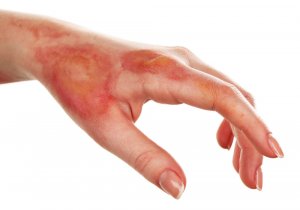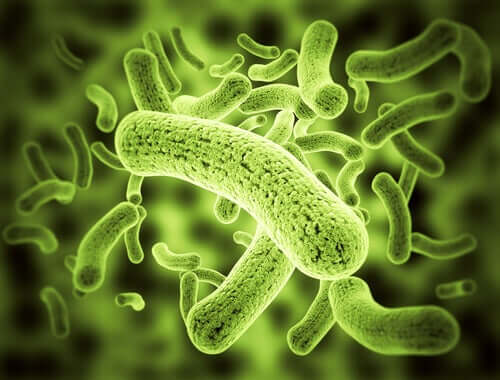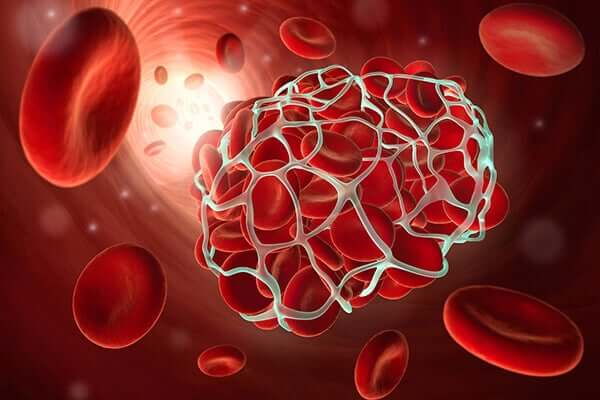Diagnosis of Skin Necrosis

The diagnosis of skin necrosis is complex because it isn’t specific to any particular pathology. Many different causes can lead to it. Therefore, to establish the diagnosis, the medical professional needs to carefully examine the patient’s symptoms.
The medical professionals should also consider the patient’s medical history, as well as any associated diseases and other symptoms, along with the lab test results. The analysis of all these aspects is what allows them to reach a specific diagnosis.
Be that as it may, the truth is that skin necrosis is a very serious disease. Once it occurs and develops, it becomes irreversible. Therefore, it’s essential to act quickly to establish its cause and choose the appropriate treatment.
What’s skin necrosis?

Skin necrosis is the death of a group of cells or tissue due to pathological reasons. The process starts due to a harmful agent that causes a severe enough injury that’s impossible to cure.
It’s common for skin necrosis to manifest as skin discoloration (violet, blue, or black skin). There’s a loss of feeling in the area, which is sometimes preceded by intense pain. Also, the patient may suffer from a foul-smelling secretion.
Typically, an eschar covers skin necrosis. A pressure ulcer or bedsore consists of black tissue buildup with defined limits. Also, it’s rough and completely adheres to the lesion.
This process can lead to tissue death in a large area of the skin, due to a lack of blood supply. If a bacterial infection and decay accompany this process, then we’re talking about gangrene.
This article may interest you: How to Treat an Infected Wound
Main causes

Many different causes can lead to skin necrosis, and this is why it’s difficult to diagnose. However, three factors usually play a role. These are:
- Exogenous agents. External factors that result in necrosis. For example, chemical factors, bedsores, drugs, burns, and frostbite, among others.
- Infections. Certain infections lead to skin necrosis. Some of them are gas gangrene, ecthyma, acute meningococcemia, and necrotizing fasciitis.
- Vascular occlusion. This is the most common cause. It may be due to multiple sources, such as cryoglobulinemia, vasculitis, thrombotic phenomena, and other hemostasis alterations, among others.
Many other causes can lead to skin necrosis. Also, often, various factors interact and result in this condition.
This article may interest you: 6 Natural Treatments to Help with Blood Clot Problems
Processes that manifest with necrosis due to infection
All factors that lead to skin necrosis are conditions that occur simultaneously. In the case of skin necrosis due to infection, the associated processes are usually:
- Ecthyma. A bacterial infection that causes ulcers and scabs.
- Necrotizing fasciitis. This condition causes fast necrosis of the subcutaneous fat and fascia, which produces an aqueous and smelly liquid.
- Gas gangrene. A muscle infection that spreads rapidly and may lead to death.
- Acute meningococcemia. It causes acute petechial rash, which may be followed by ecchymosis and ischemic necrosis. Sometimes, it causes bleeding blister-like skin lesions.
Processes that produce necrosis due to vascular occlusion
In the case of skin necrosis due to vascular occlusion, these accompanying processes often produce:
- Antiphospholipid syndrome (APS). This is an immune disorder in which the body mistakenly attacks blood proteins.
- Cryoglobulinemia. This is a rare disease, often associated with hepatitis C. It causes the affected patient’s blood proteins to thicken at low temperatures.
- Cholesterol embolization syndrome (CES). This is a rare disease that occurs mainly in men over 60 with generalized arteriosclerosis. It’s characterized by the release of cholesterol crystals.
- Likewise, calciphylaxis. This is a rare and potentially fatal syndrome. It causes the calcification of blood vessels and is characterized by progressive and painful ulcers.
- Necrotizing vasculitis. It corresponds to a group of disorders that cause inflammation of blood vessel walls.
- Hemostasis alterations. It comprises a set of conditions in which the normal activation of platelets is altered, which affects blood vessel walls.
As you can see, many different processes are associated with skin necrosis. This is why its diagnosis is so complex.
All cited sources were thoroughly reviewed by our team to ensure their quality, reliability, currency, and validity. The bibliography of this article was considered reliable and of academic or scientific accuracy.
- Martorell-Calatayud, A., Serra Guillén, C., & Sanmartín, O. (2010). Necrosis cutánea como factor predictivo de neoplasia en la dermatomiositis. Actas dermo-sifiliograficas, 101(5), 455-456.
This text is provided for informational purposes only and does not replace consultation with a professional. If in doubt, consult your specialist.








